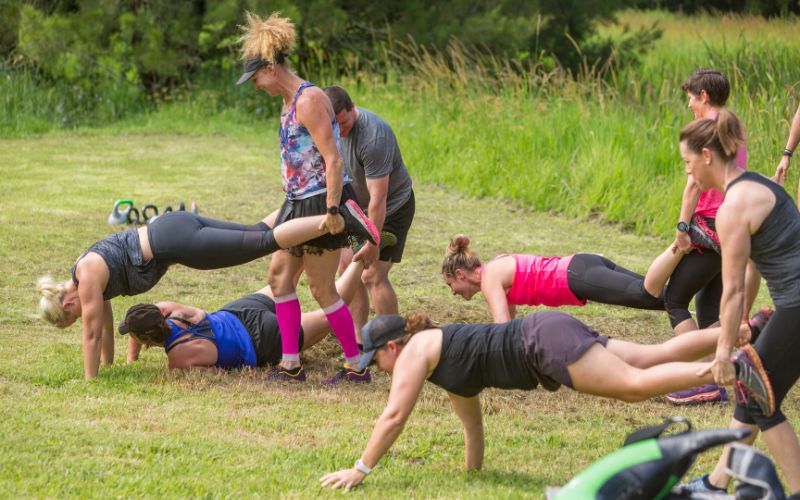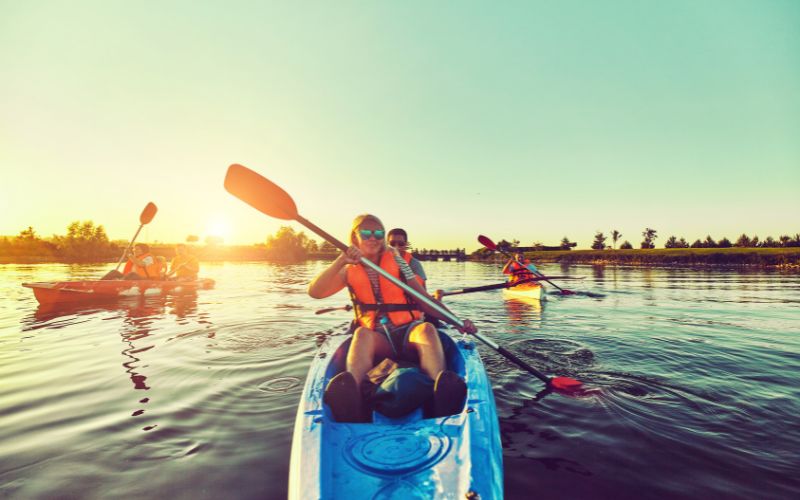
Camping and Calisthenics: Staying Fit While Enjoying the Super Outdoors 2023
Camping and Calisthenics represent two incredible ways to engage with nature and improve your physical well-being. This guide explores how you can seamlessly integrate calisthenics—a form of exercise that utilizes your body weight—into your camping adventures. We’ll delve into essential exercises, equipment, and strategies for staying fit while savoring the great outdoors.

Table of Contents
The Marriage of Camping and Calisthenics
The combination of camping and calisthenics is like a beautifully choreographed dance between your body and nature. It’s a partnership that offers multifaceted benefits, enhancing your camping experience and promoting your overall well-being.
A Symbiotic Relationship
Camping and calisthenics are inherently symbiotic. Here’s how they complement each other:
Camping’s Gift to Calisthenics:
- Inspiring Backdrops: When you set up your campsite in the heart of nature, you’re surrounded by awe-inspiring landscapes. The towering trees, pristine lakes, and rugged mountains serve as the perfect backdrop for your outdoor workouts. The natural beauty is not just visually appealing but also spiritually uplifting, motivating you to push your physical limits.
- Outdoor Gym: Nature provides an open-air gym without the need for any membership fees. From tree branches to boulders, nature offers a plethora of exercise equipment. Your campsite becomes your fitness sanctuary, with every tree stump and flat rock potentially becoming a part of your workout routine.
- Mindful Connection: Camping encourages mindfulness and a deep connection with the environment. As you immerse yourself in the natural world, you become attuned to the present moment. This mindfulness seamlessly integrates with calisthenics, allowing you to focus on your exercises with heightened awareness.

Calisthenics’ Gift to Camping:
- Physical Preparedness: Engaging in regular calisthenics workouts before and during your camping trip enhances your physical preparedness. You build strength, endurance, and flexibility—attributes that prove invaluable when setting up your campsite, carrying gear, and navigating the trails.
- Energy and Vitality: Calisthenics keeps you energized and ready for the demands of camping. Whether you’re hiking to your campsite, chopping firewood, or exploring nearby trails, your fitness levels are primed to meet the challenges head-on.
- Functional Fitness: The beauty of calisthenics lies in its emphasis on functional fitness. Every exercise you perform has a real-world application. From lifting heavy gear to maintaining balance on uneven terrain, your calisthenics training directly translates into improved camping performance.
Holistic Well-Being
Beyond the physical benefits, this marriage fosters holistic well-being:
- Mental Clarity: Both camping and calisthenics promote mental clarity. The tranquility of nature combined with the endorphin release from exercise clears your mind, allowing you to appreciate the beauty around you fully.
- Stress Relief: The serenity of the wilderness and the rhythmic flow of calisthenics movements offer profound stress relief. Camping provides a natural escape from the pressures of daily life, while calisthenics serves as a therapeutic outlet.
- Community and Connection: Camping often involves shared experiences with friends or family, creating lasting memories and strengthening bonds. Calisthenics can be a shared activity, fostering a sense of community even in remote settings.
- Embracing Challenges: Both pursuits encourage you to embrace challenges. Camping presents unpredictable weather and terrain, while calisthenics challenges you to push your physical limits. Overcoming these challenges builds resilience and self-confidence.
Environmental Respect
This marriage also instills a deep respect for the environment:
- Leave No Trace Philosophy: Calisthenics enthusiasts who camp are often passionate advocates for the Leave No Trace principles. They understand the importance of preserving the natural world and strive to minimize their impact on it.
- Environmental Awareness: Camping and calisthenics enthusiasts are more likely to be attuned to environmental changes. They observe subtle shifts in nature, from the changing seasons to wildlife behaviors, fostering a profound connection to the environment.
A Journey of Growth
In conclusion, the marriage of camping and calisthenics is not just a combination of activities; it’s a journey of personal growth and enrichment. It invites you to step outside your comfort zone, explore the wilderness, and discover your physical and mental capabilities. This union nurtures a deeper appreciation for the natural world, fuels your passion for fitness, and creates lasting memories that resonate long after you’ve packed up your campsite.

So, as you embark on your camping and calisthenics adventures, remember that this marriage is more than the sum of its parts. It’s an exploration of the self, a celebration of nature, and a testament to the limitless potential of the human spirit. Embrace it with open arms, and let it guide you on a path of discovery and well-being like no other.
The Power of Calisthenics
Calisthenics is not merely a set of exercises; it’s a versatile and empowering form of bodyweight training that unleashes the full potential of your physique. Its simplicity, efficiency, and adaptability make it the ideal companion for your camping journeys.

Minimalist Elegance
Calisthenics is the art of using your own body as the ultimate fitness tool. It requires no elaborate equipment, machines, or weights. This minimalist approach is in perfect harmony with the essence of camping, where simplicity and self-sufficiency reign supreme.
Key Characteristics of Calisthenics:
- Bodyweight Resistance: Every calisthenics exercise relies on your body weight as resistance. This fundamental principle means you can perform these exercises virtually anywhere, whether you’re at a campsite, in a forest clearing, or beside a mountain stream.
- Functional Fitness: Calisthenics prioritizes functional fitness, meaning that the exercises mimic real-life movements and improve your ability to perform daily tasks. This functional strength is invaluable when setting up your campsite, carrying gear, and navigating the challenges of the outdoors.
- Versatility: Calisthenics offers a diverse array of exercises that target various muscle groups. From push-ups and squats to pull-ups and planks, you can tailor your workouts to match your fitness level and goals.
- Progression: Calisthenics caters to individuals of all fitness levels. Beginners can start with basic exercises, gradually progressing to more advanced movements as they build strength and confidence. The adaptability of calisthenics ensures that it remains a lifelong fitness companion.
Benefits of Calisthenics in Camping
Integrating calisthenics into your camping routine brings a myriad of benefits:
- Strength and Endurance: Calisthenics builds functional strength and endurance that directly benefit your camping experience. You’ll find tasks such as setting up tents, chopping wood, and carrying packs less physically demanding.
- Improved Flexibility: Calisthenics exercises often include dynamic stretching movements that enhance flexibility. This flexibility can be especially useful when navigating uneven terrain or performing campsite chores that require bending and reaching.
- Balanced Fitness: Calisthenics promotes a balanced fitness profile. It targets not only major muscle groups but also stabilizer muscles, improving overall stability and coordination.
- Mental Resilience: The discipline required for consistent calisthenics practice fosters mental resilience—a quality that serves you well in the face of camping challenges like unexpected weather or difficult trails.
- Energy Conservation: As your fitness improves through calisthenics, you become more efficient in expending energy. This efficiency can translate to longer hikes, more exploration, and a deeper connection with the outdoors.
Calisthenics: A Portable Gym
When camping, your campsite becomes your outdoor gym, and calisthenics exercises are your go-to routines. Here are a few essential exercises for your camping and calisthenics regimen:
- Push-Ups: Strengthen your chest, triceps, and shoulders.
- Bodyweight Squats: Target your quadriceps, hamstrings, and glutes.
- Pull-Ups: Focus on your back, biceps, and shoulders.
- Planks: Engage your core muscles for stability and strength.
- Lunges: Work your legs and glutes while improving balance.
- Dynamic Stretches: Incorporate dynamic stretching exercises into your warm-up and cooldown routines to improve flexibility.
These exercises can be performed at your campsite, on hiking trails, or in open clearings, adding a dynamic dimension to your outdoor experience.
Connecting with Nature
Calisthenics, when practiced in the great outdoors, fosters a profound connection with nature. The serene surroundings of your campsite become the backdrop for your workouts, imbuing each exercise with a sense of mindfulness. As you breathe in the fresh forest air or savor the mountain vistas, you’ll find that calisthenics transcends the physical—it becomes a meditative practice that aligns your body and spirit with the natural world.
In conclusion, the power of calisthenics lies not only in its ability to sculpt your physique but also in its capacity to enhance your camping adventures. It embodies the spirit of self-reliance and adaptability, making it the perfect fitness companion for those who seek to combine physical well-being with a deep appreciation for the outdoors. As you embark on your camping journeys, let calisthenics be your guide to strength, balance, and the harmonious union of body and nature.
Planning Your Camping and Calisthenics Adventure
Before you embark on your camping and calisthenics journey, thoughtful planning is key. Consider the following aspects:
Choosing the Right Campsite
The foundation of your adventure begins with selecting the perfect campsite:
Location: Opt for campgrounds or wilderness areas that permit camping and have ample space for calisthenics routines. National and state parks often provide suitable environments.
Terrain: Look for flat, well-drained areas for setting up your campsite and exercise space. Ensure there’s enough room to perform exercises safely.
Facilities: Check if the campsite has amenities such as clean water sources, restrooms, and designated fire pits for cooking.
Calisthenics-Friendly Gear
Selecting the right gear ensures your camping and calisthenics experience is seamless:
Tent: Choose a lightweight and spacious tent that accommodates your camping gear and provides shelter in various weather conditions.
Comfortable Clothing: Pack moisture-wicking and breathable clothing suitable for both camping and exercising. Layers are essential to adapt to temperature changes.
Footwear: Invest in sturdy yet comfortable hiking shoes or boots that support your feet during campsite setup and trail exploration.
Calisthenics Equipment: While calisthenics primarily relies on bodyweight, consider bringing portable equipment like resistance bands, a yoga mat, or gymnastic rings to diversify your workouts.
Meal Planning
Maintaining energy levels is crucial. Plan nutritious, easy-to-prepare camping meals:
Camp Cooking: Bring a portable camping stove or campfire cooking gear. Opt for lightweight, non-perishable food items like dehydrated meals, nuts, and dried fruits.
Hydration: Ensure you have access to clean drinking water. Consider carrying a water purification system or portable filter.
Meal Timing: Coordinate your meals with your exercise routine to fuel your workouts effectively.
The Essentials of Outdoor Calisthenics
Now, let’s delve into the essential calisthenics exercises tailored for your camping adventure. These exercises target various muscle groups and require minimal equipment.
Warm-Up Routine
Begin with a dynamic warm-up to prepare your body for exercise. Include exercises like leg swings, arm circles, and bodyweight squats to increase blood flow and flexibility.
Push-Ups (Chest and Triceps)
Push-ups are a versatile exercise that targets the chest, triceps, and shoulders. Perform them on flat ground or using a yoga mat for comfort.
Technique:
- Start in a plank position with your hands shoulder-width apart.
- Lower your body until your chest nearly touches the ground.
- Push back up to the starting position, keeping your body in a straight line.
Bodyweight Squats (Legs)
Bodyweight squats strengthen the quadriceps, hamstrings, and glutes. They can be done anywhere with enough space to stand.
Technique:
- Stand with your feet shoulder-width apart.
- Lower your body by bending your knees and hips.
- Keep your back straight and chest up as you descend.
- Rise back to the starting position.
Pull-Ups (Back and Biceps)
Pull-ups target the upper back, biceps, and shoulders. Find a sturdy tree branch or horizontal bar to perform this exercise.
Technique:
- Hang from the bar with your palms facing away from your body.
- Pull your body up until your chin is above the bar.
- Lower yourself back down to a hanging position.
Planks (Core)
Planks engage the core muscles, including the abdomen and lower back. They are excellent for improving overall stability.
Technique:
- Start in a push-up position with your elbows bent and forearms resting on the ground.
- Keep your body in a straight line from head to heels, engaging your core.
- Hold this position for as long as you can.
Lunges (Legs and Glutes)
Lunges target the legs and glutes and can be done on level ground.
Technique:
- Stand with your feet together.
- Take a step forward with one foot, lowering your body until both knees are bent at 90-degree angles.
- Push off the front foot to return to the starting position.
- Alternate between legs.
Cooldown and Stretching
Finish your calisthenics session with static stretching exercises to improve flexibility and reduce muscle tension.
Staying Safe and Respectful
Safety First
Prioritizing safety is non-negotiable when engaging in camping and calisthenics. Here’s how to ensure a safe and enjoyable experience:
Injury Prevention:
- Proper Form: Execute calisthenics exercises with correct form to minimize the risk of injuries. Maintain body alignment and engage the right muscle groups.
- Warm-Up: Always warm up before your workout to increase blood flow and reduce the risk of strains or sprains.
- Know Your Limits: Don’t push yourself beyond your fitness level. Progress gradually and listen to your body’s signals.
- Supervise Newcomers: If camping with beginners or children, supervise their calisthenics activities to ensure they perform exercises safely.
Sun Protection:
- Sunscreen: Apply sunscreen with sufficient SPF to protect your skin from harmful UV rays.
- Hydration: Stay hydrated to prevent heat-related issues. Carry a water bottle and drink regularly, especially in warm weather.
- Apparel: Wear appropriate clothing, including a hat and lightweight, moisture-wicking fabric to stay cool and shielded from the sun.
Wildlife Awareness:
- Educate Yourself: Learn about the local wildlife and their behavior. Understand what precautions to take in areas with potentially dangerous animals.
- Food Storage: Keep food securely stored to prevent attracting wildlife to your campsite.
- Bear Safety: If camping in bear country, follow specific bear safety guidelines, including proper food storage and bear-resistant containers.
Leave No Trace
Preserving the natural beauty of the outdoors is a collective responsibility. Adhering to Leave No Trace principles ensures that future generations can enjoy pristine wilderness:
Pack Out Trash:
- Trash Disposal: Carry all trash out of the wilderness. Use designated trash containers or portable trash bags.
- Biodegradable Waste: If disposing of human waste, follow guidelines for proper disposal, such as using a portable toilet or digging a cat hole.
Minimize Impact:
- Stay on Trails: Stick to established trails and campsites to minimize soil erosion and protect fragile ecosystems.
- Campsite Selection: Choose campsites that have already been impacted to minimize further damage. Camp at least 200 feet from lakes and streams to protect water quality.
- Campfires: Follow campfire regulations. In some areas, fires may be prohibited or restricted to designated fire rings.
- Respect Wildlife: Observe wildlife from a distance, and avoid feeding them. Feeding wildlife can harm their health and disrupt their natural behaviors.
Natural Sounds:
- Noise Pollution: Keep noise levels to a minimum. Loud noises can disturb wildlife and other campers seeking a tranquil experience.
- Quiet Hours: Respect designated quiet hours in campgrounds to allow everyone to enjoy a peaceful night’s rest.
Safety and Respect Go Hand-in-Hand
Safety and environmental respect are intertwined. When you prioritize safety, you inherently respect the natural world and fellow campers. By following safety guidelines and Leave No Trace principles, you not only protect yourself but also contribute to the preservation of wilderness areas.
Camping and calisthenics provide an opportunity to reconnect with nature and enhance physical fitness. By doing so responsibly and respectfully, you ensure that these experiences remain accessible and enjoyable for generations to come. So, as you embark on your camping and calisthenics adventures, remember that safety and respect for the environment are integral components of a harmonious outdoor experience.
Conclusion
Camping and calisthenics offer a unique blend of physical fitness and outdoor exploration. By planning carefully, selecting the right gear, and incorporating essential calisthenics exercises, you can embark on a rewarding journey that enhances both your fitness and your connection with the natural world. Whether you’re practicing push-ups under the forest canopy or lunging on a mountaintop, the combination of camping and calisthenics creates a harmonious union of body and nature—a truly enriching experience that rejuvenates your spirit and strengthens your body. So, lace up your hiking boots, set up your campsite, and embrace the joy of staying fit while enjoying the outdoors through camping and calisthenics.
You might also like:
Popular Stories
Newsletter
About me
Meet Dennis, an enthusiast of the great outdoors. For the past 15 years, he’s maintained a daily routine that includes running, hiking, and hitting the gym, embodying a commitment to an active and healthy lifestyle.
Dennis is a true advocate for the joy and rejuvenation that outdoor living can bring.



